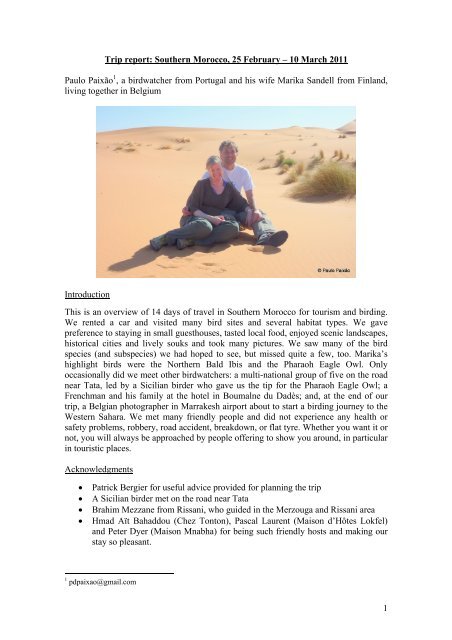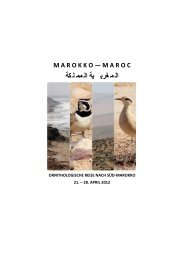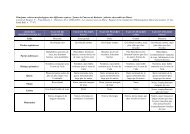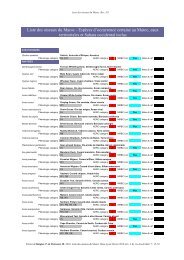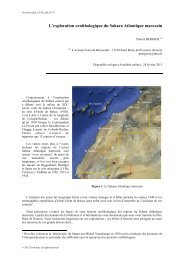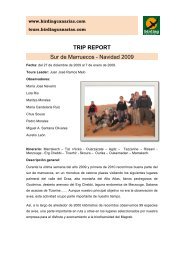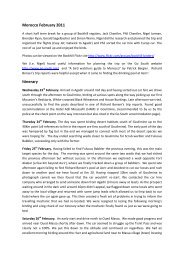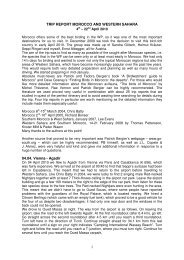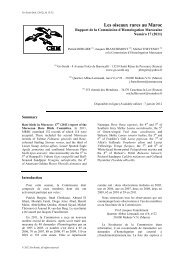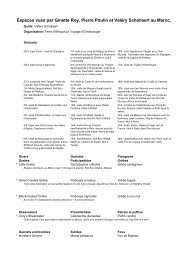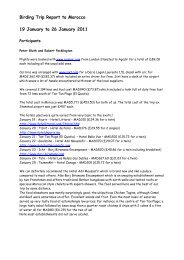Trip report: Southern Morocco, 25 February – 10 March ... - Go-South
Trip report: Southern Morocco, 25 February – 10 March ... - Go-South
Trip report: Southern Morocco, 25 February – 10 March ... - Go-South
You also want an ePaper? Increase the reach of your titles
YUMPU automatically turns print PDFs into web optimized ePapers that Google loves.
<strong>Trip</strong> <strong>report</strong>: <strong><strong>South</strong>ern</strong> <strong>Morocco</strong>, <strong>25</strong> <strong>February</strong> <strong>–</strong> <strong>10</strong> <strong>March</strong> 2011<br />
Paulo Paixão 1 , a birdwatcher from Portugal and his wife Marika Sandell from Finland,<br />
living together in Belgium<br />
Introduction<br />
This is an overview of 14 days of travel in <strong><strong>South</strong>ern</strong> <strong>Morocco</strong> for tourism and birding.<br />
We rented a car and visited many bird sites and several habitat types. We gave<br />
preference to staying in small guesthouses, tasted local food, enjoyed scenic landscapes,<br />
historical cities and lively souks and took many pictures. We saw many of the bird<br />
species (and subspecies) we had hoped to see, but missed quite a few, too. Marika’s<br />
highlight birds were the Northern Bald Ibis and the Pharaoh Eagle Owl. Only<br />
occasionally did we meet other birdwatchers: a multi-national group of five on the road<br />
near Tata, led by a Sicilian birder who gave us the tip for the Pharaoh Eagle Owl; a<br />
Frenchman and his family at the hotel in Boumalne du Dadès; and, at the end of our<br />
trip, a Belgian photographer in Marrakesh airport about to start a birding journey to the<br />
Western Sahara. We met many friendly people and did not experience any health or<br />
safety problems, robbery, road accident, breakdown, or flat tyre. Whether you want it or<br />
not, you will always be approached by people offering to show you around, in particular<br />
in touristic places.<br />
Acknowledgments<br />
• Patrick Bergier for useful advice provided for planning the trip<br />
• A Sicilian birder met on the road near Tata<br />
• Brahim Mezzane from Rissani, who guided in the Merzouga and Rissani area<br />
• Hmad Aït Bahaddou (Chez Tonton), Pascal Laurent (Maison d’Hôtes Lokfel)<br />
and Peter Dyer (Maison Mnabha) for being such friendly hosts and making our<br />
stay so pleasant.<br />
1 pdpaixao@gmail.com<br />
1
Getting there<br />
Flights with TAP Air Portugal: Brussels-Lisbon-Marrakesh and return, staying a few<br />
days in Lisbon each way, for 335 € each.<br />
Car hire<br />
Given that several trip <strong>report</strong>s recommended Dacia Logan for birding in <strong>Morocco</strong>, we<br />
had booked a “Dacia Logan or similar” through the Autoeurope website for 364 € 2 and<br />
received a voucher to pick it up from the Avis counter in Marrakesh airport. However,<br />
to our surprise and disappointment, we did not get this car because Avis said that it is<br />
not part of their fleet anymore. Instead, they gave us a Peugeot 206+, which is less<br />
convenient for occasional track driving. Moreover the boot was too small for our<br />
luggage. We complained to no avail. The tank was full but the car was not washed when<br />
we returned it at the end of the trip. Avis did not claim any extra payment. We travelled<br />
3400 km, at an average of 5,4 litres of unleaded petrol per <strong>10</strong>0 km, petrol price being<br />
around <strong>10</strong>,4 dirhams / litre.<br />
Taxi<br />
Bargaining is common practice, even for taxi rides. One taxi driver requested 200<br />
dirhams to take us back from Menara airport to Marrakesh centre, but accepted a quite<br />
reasonable fare of 80 dirhams.<br />
Police<br />
Checkpoints were frequent, in particular on the way in or out of towns. However, only a<br />
couple of times did the police order us to stop. It happened once at a checkpoint on the<br />
way into Tan-Tan to query about our itinerary and professions and twice near Foum El<br />
Hisn (between Guelmim and Tata) to reprimand us for traffic offences 3 .<br />
Money<br />
Currency exchange rate around 11 dirhams per euro, slightly worse (<strong>10</strong>,7) in the<br />
baggage claim area of the airport.<br />
Communications<br />
We bought a Maroc Telecom mobile phone number from the shop at the airport. It cost<br />
50 dirhams to get a number and we chose a 200 dirhams prepaid card that converted<br />
into 400 dirhams call credit. This is a good option for both local and international calls,<br />
as it becomes much cheaper than using a European mobile in roaming mode.<br />
2 Including unlimited mileage, second driver, fire insurance, liability insurance, collision damage<br />
coverage and theft protection with an excess of 12,000 dirhams, with fully refundable excess (with some<br />
exclusions) from Autoeurope.<br />
3 There was very little road traffic. We stopped on the hard shoulder on the left hand side of the road and<br />
were sitting in the car looking at birds. A policeman not in uniform stopped his car, showed a badge and<br />
introduced himself as “agent de la gendarmerie royale”. He said that we had committed an offence by<br />
having parked on the left side and requested the car documents. Then he simply warned us not do it again.<br />
Later on, having stopped that time on the right hand side, we saw his car coming again. He waved at us<br />
but did not stop. Further ahead we found him again with a police patrol that stopped and reprimand us for<br />
having parked on a bridge. Actually the place did not look like a bridge as most rivers are completely dry<br />
and only occasionally the water flows over these lowered stretches of the road. New warning, but no fine.<br />
2
Accommodation<br />
Although we had only booked accommodation for the first and last nights, we never<br />
experienced any difficulty in finding suitable accommodation during the trip in the<br />
places we had chosen. Sometimes there were no other guests apart from us. However,<br />
during peak periods such as Easter, some places may be fully booked months in<br />
advance.<br />
Date Town Name Price<br />
(dirhams)<br />
Room Breakfast Dinner<br />
<strong>25</strong>-26.2 Essaouira Residence Vent<br />
des Dunes 4<br />
440 a <strong>Go</strong>od Excellent -<br />
26-27.2 Paradise Auberge Bab<br />
Valley Imouzzer 5<br />
4<strong>25</strong> b <strong>Go</strong>od <strong>Go</strong>od <strong>Go</strong>od<br />
27-28.2 Taroudant Hotel Tiout 6 350 a OK OK -<br />
28.2-1.3 370 c Guelmin Hotel Adil<br />
<strong>Go</strong>od <strong>Go</strong>od<br />
1-2.3<br />
Moussafir 7 370 c<br />
Excellent<br />
<strong>Go</strong>od -<br />
2-3.3 Tata Le Relais des 488 b OK <strong>Go</strong>od <strong>Go</strong>od<br />
Sables 8<br />
3-4.3 Agdz Auberge<br />
d’Ouriz 9<br />
360 b <strong>Go</strong>od Excellent Excellent<br />
4-5.3 400 b Merzouga Chez Tonton Excellent Excellent<br />
5-6.3<br />
<strong>10</strong><br />
400 b<br />
Excellent<br />
Excellent Excellent<br />
6-7.3 Boumalne<br />
du Dadès<br />
Le Soleil Bleu 11 400 b OK Excellent Excellent<br />
7-8.3 Aït Ben Maison d'Hôtes<br />
Haddou Lokfel 12<br />
470 a Excellent Excellent Excellent<br />
8-9.3 885 a Marrakesh Maison<br />
Excellent -<br />
9-<strong>10</strong>.3<br />
Mnabha 13 885 a<br />
Excellent<br />
Excellent -<br />
a<br />
Double room and breakfast for two.<br />
b<br />
Double room, breakfast and dinner (drinks not included) for two.<br />
c Double room only.<br />
4 http://www.essaouiranet.com/ventdesdunes - simple but very nice room, big breakfast with plenty of<br />
choice on the sunny terrace, good service<br />
5 http://aubergeimouzzer.unblog.fr/ - new guesthouse in a splendid location, good service, meals served<br />
next to our room because we complained of a strong smell of wet paint from freshly painted dining room<br />
6 http://www.hoteltiout.com/ - very basic room in need of renovation, simple breakfast with little choice<br />
7 http://hoteladilmoussafir.com/ - modern international style, like a 3 or 4-star hotel, breakfast à la carte<br />
available at the hotel café<br />
8 we could not find a website for this hotel - the cheap room was a spartan diminute cell, difficult to close<br />
the door, no hot water, good service by the waiters in an otherwise sad dining room atmosphere<br />
9 http://www.ouriz.com - family-run, dedicated to fair and ecotourism, traditional local style architecture,<br />
home-made food<br />
<strong>10</strong> http://www.cheztonton-merzouga.com - family-run, sociable and helpful owner, traditional local style<br />
architecture, home-made food<br />
11 http://www.hotelsoleilbleu.com/ - the cheap room needed renovation, intermitent water temperature<br />
from very hot to cold<br />
12 http://www.lokfel.com/ - charming place, with nice details, sociable owner, great food<br />
13 http://www.maisonmnabha.com - charming riad with nice details, helpful and knowledgeable owner,<br />
varied and plentiful breakfast<br />
3
Books, maps, websites<br />
• Svensson, L., Mullarney, K., Zetterström, D. & Grant, P. 2009. Collins Bird<br />
Guide. 2 nd edition. ISBN 978-0-00-726814-6.<br />
• Bergier, P. & Bergier, F. 2003. A Birdwatcher’s Guide to <strong>Morocco</strong>. Bird<br />
Watchers’ Guides. Prion Ltd, Cley. ISBN 1 871<strong>10</strong>4 09 2.<br />
• Bergier, P. & Bergier, F. <strong>Go</strong>-<strong>South</strong>. Birds and Nature in <strong>Morocco</strong>.<br />
http://www.go-south.org/ and several trip <strong>report</strong>s uploaded on this website<br />
• Clammer, P., Bing, A., Sattin, A. & Stiles, P. 2009. <strong>Morocco</strong>. Lonely Planet. 9 th<br />
edition. ISBN 978-1-74<strong>10</strong>4-971-8.<br />
• Maroc. 2009. Michelin map 742 National 1/1 000 000. 5 th edition. ISBN 978-2-<br />
06-714648-8.<br />
Equipment<br />
• Binoculars: Swarovski SLC <strong>10</strong>x42 HD<br />
• Spotting scope: Kite KSP HD80 + <strong>25</strong>-50x WA eyepiece<br />
• <strong>Trip</strong>od: Kite Ardea CF + Manfrotto 128 RC head<br />
• DSLR camera and lenses: Canon EOS 550D + Canon EF-S 18-55 mm 1:3.5-5.6<br />
IS + Canon EF <strong>10</strong>0-400 mm 1:4.5-5.6 IS<br />
• Point & shoot camera: Panasonic Lumix DMC-TZ6<br />
Itinerary<br />
From Marrakesh, westwards to Essaouira, southwards to Tan-Tan, eastwards to<br />
Merzouga, westwards to Marrakesh.<br />
Wheather<br />
Fine sunny weather, blue sky and temperature (°C) in mid-20s most of the days, above<br />
30 in Souss, less than <strong>10</strong> in Boumalne, 15 and rain in Marrakesh.<br />
Species<br />
84 bird species observed, of which Paulo recorded 22 lifers and a few new subspecies 14 .<br />
Most of these were resident birds, some wintering and very few passage migrants. It<br />
was still too early in the season for most migrant breeders. Some identification issues<br />
may not have been totally resolved. Uncertain about Crag or Rock Martin, we always<br />
opted for Crag Martin. We might have overlooked Iberian Chiffchaff or Willow<br />
Warbler among the Chiffchaffs. Because little time was spent scanning the gulls, we did<br />
not look for rings and might have overlooked other species among the Yellow-legged<br />
Gulls.<br />
Species that we would have liked to see, but failed to find were: Bonelli's Eagle, Blackcrowned<br />
Tchagra, Brown-throated Sand Martin, Sandgrouse (Black-bellied, Pin-tailed,<br />
Spotted, Crowned and Lichtenstein's), Cream-coloured Courser, Thick-billed Lark,<br />
Maghreb Wheatear, Scrub Warbler, Spectacled Warbler, African Desert Warbler and<br />
Fulvous Babbler, as well as the local subpersonata subspecies Moroccan White<br />
Wagtail. These are species that should have been present at this time of the year in the<br />
14 Bird records kept at http://birdstack.com/people/pdpaixao/trips/4084<br />
4
egions and habitat types that we visited. Reasons for failure to see them might have<br />
been a wrong strategy, wrong time of the day, climate (drier conditions), lack of<br />
persistence, lack of time, or just bad luck. Although having managed to visit so many<br />
sites and habitat types is highly satisfactory, had we paid a little bit more attention to<br />
planning details, birding quality could have improved. We wish we could have also<br />
spent more time in certain areas to fully explore the touristic potential of the region. To<br />
be taken into account in future trips to the region … insha’Allah!<br />
Apart from Dromedaries, <strong>Go</strong>ats and Sheep flocks minded by shepherds, we found<br />
apparently free roaming Donkeys and more Dromedaries, too. Wild mammals included<br />
the ubiquitous Barbary Ground Squirrels and one <strong>Go</strong>lden Jackal near Tata. Herps<br />
included Desert Agama in Paradise Valley and Spanish Terrapin in Oued Assaka.<br />
Diary<br />
<strong>25</strong> <strong>February</strong>: Lisboa, Marrakesh, Essaouira<br />
We landed on time in Marrakesh Menara airport. Still in the airport, we exchanged<br />
money, bought a local mobile phone number and sorted out the car hire with Avis. It<br />
was already dark when we proceeded to Essaouira, where we arrived at <strong>10</strong>.30 pm and<br />
slept at "Hotel Vent des Dunes".<br />
26 <strong>February</strong>: Essaouira, Oued Tamri, Paradise Valley<br />
We woke up with the early calls of Common Bulbul. A great breakfast at the hotel's<br />
roof terrace in the sun gave us a nice start to our holiday. Great views of Yellow-legged<br />
Gull walking on the balcony and House Sparrow, Common Bulbul and Spotless Starling<br />
(in summer plumage) perched on aerials and Pallid Swift flying above in the sky.<br />
We visited the city of Essaouira inside the walls, where House Bunting is widespread.<br />
We bought fresh fish on the market and had it grilled in a restaurant. We also went for a<br />
walk in the fishing harbour. Outside the walls, there were many Yellow-legged Gulls on<br />
the sandy beach, at the rocky seaside and fishing harbour. The rocks also produced<br />
Little Egret, Lesser Black-backed Gull, Greater Black-backed Gull and Great<br />
Cormorant of the maroccanus subspecies. Due to our ambitious itinerary we decided<br />
not to visit the mouth of the Oued Ksob to the south of Essaouira 15 .<br />
15 After the trip, at the time of writing this <strong>report</strong>, we became aware that the waste treatment plant to the<br />
north of Essaouira is another interesting site for ducks, waders and passerines, to be considered in birding<br />
visits to this area.<br />
5
The road from Essaouira towards Agadir went through Argan forests. We paid a visit to<br />
a women's agro-business co-operative and got acquainted with the processing of the<br />
argan fruit for the production of edible oil, cosmetics and soap. Another stop on the road<br />
provided close looks of Greenfinch, small flocks of Chaffinch of the africana<br />
subspecies and Crested Lark.<br />
In the late afternoon, we stopped at the beachfront on the southern side (left bank) of<br />
Oued Tamri in search of Northern Bald Ibis. We did not find it, but could see 1<br />
Spoonbill, 4 Grey Heron, 1 Cattle Egret and 2 Great Cormorant of the sinensis<br />
subspecies in the estuary. Sardinian Warbler and Zitting Cisticola visited the bushes.<br />
We decided to come back the day after at lunchtime to search for Bald Ibis. In the<br />
meantime we headed to Paradise Valley without stopping at Cap Rhir. We arrived late<br />
at the new "Auberge Bab Imouzzer", were we had dinner and a good nights rest.<br />
27 <strong>February</strong>: Paradise Valley, Oued Tamri, Taroudant (via Agadir)<br />
We started birding at the first light in the woods around the hotel. <strong>Go</strong>od views of<br />
Common Bulbul, Blackbird, Cirl Bunting, Great Tit and Serin. We then spent the early<br />
morning driving through Paradise Valley back to the coast passing by palm and banana<br />
groves surrounded by mixed woods. Groups of people were arriving for Sunday picnics.<br />
We found Moussier's Redstart, House Sparrow and Common Bulbul.<br />
6
By the coast, we found a flock of Greenfinch and two Great Grey Shrike. At Oued<br />
Tamri, we parked on the same beach track as the day before. We had just spotted<br />
Northern Bald Ibis when a local showed up asking 50 dirhams to show us these birds.<br />
We refused, but offered him a coin to look after the car while we went birding the area.<br />
We walked northwards along the beach until the river mouth, where we had a closer<br />
look at 16 Bald Ibis. They were feeding by scratching on the ground and 3 of them<br />
walked down to drink water. We also saw <strong>10</strong> Kentish Plovers on the flat river shore and<br />
some hiding almost invisible on the pebbles. There were 92 Audouin's Gulls among the<br />
many Yellow-legged Gulls. The estuary had 1 Spoonbill, 6 Grey Heron, 5 Little Egret<br />
and 3 Great Cormorant. The bushes had Zitting Cisticola and Stonechat.<br />
We drove around the estuary towards the right bank, past the town of Tamri in the<br />
direction of Essaouira. We aimed at finding more Bald Ibis and managed to see 5 more<br />
individuals that took flight when someone walked nearby. Some of the other 16 also<br />
moved down to the estuary. A Common Kestrel was perched on a wall.<br />
Because it was windy and getting late, we did not stop at the Cap Rhir area and decided<br />
to skip all seawatching attempts. We stopped at the seashore by the small coastal town<br />
of Aghroud and found 3 Sandwich Terns and 5 Audouin's Gulls amid the very common<br />
Yellow-legged Gulls. A White Wagtail walked along the shore. Surfers were riding the<br />
waves near the surfing resort of Taghazout and Sunday afternoon strollers dotted the<br />
beaches north of Agadir.<br />
7
We drove through Agadir turning eastwards to Taroudant, seeing European Magpies<br />
and Collared Doves on the way. We arrived at this walled city in late afternoon and<br />
followed the signs to the well-indicated "Hotel Tiout" inside the medina. From the hotel<br />
car park, we scoped Common Kestrel perched on a big palm tree and spotted Little<br />
Swifts flying up in the sky. We paid a visit to the local souk, walked around the busy<br />
streets and had dinner at "Chez Nada".<br />
28 <strong>February</strong>: Taroudant, Oued Souss, Oued Massa, Guelmim<br />
Before leaving, a quick look from the hotel car park and another from the gates of the<br />
city produced 2 Common Kestrels, Little Swift, Pallid Swift, House Sparrow, House<br />
Bunting, Spotless Starling, Common Pigeon and Collared Dove.<br />
At Oued Souss, we parked the car near the military control at the track that gives access<br />
to the coast besides the wall of the royal palace. We walked a little over 1 km to the sea<br />
front, looking at the wetland bushes to the left of the track. There we watched the<br />
European Magpies of the mauritanica subspecies, exhibiting the typical blue skin<br />
behind the eye. At the end of the road we came into a rubbish tip where demolished<br />
building materials had been dumped. Despite the nature of this trash habitat, we were<br />
happy to come across several Stone Curlews, one after the other, up to 35 in total. Some<br />
were just standing, others walking fast over short distances or taking short low flights<br />
when approached. The wetland was full of other bird species: Greater Flamingo,<br />
Marbled Duck, Northern Shoveler, Grey Plover, Bar-tailed <strong>Go</strong>dwit, Black-winged Stilt,<br />
Curlew, Pied Avocet, Common Redshank, Spoonbill, Grey Heron, Little Egret, Cattle<br />
Egret, Common Kestrel, Crested Lark and Zitting Cisticola. By then, the views through<br />
the field scope were getting blurred because of the heat. As it was getting late for us, we<br />
decided to skip the seafront and move on.<br />
Back at the car, we stopped to look at an upstream stretch of the Souss river, where we<br />
found White Stork, Great Cormorant and Yellow-legged Gull. More than 30 White<br />
Storks were circling over a rubbish tip in the southern outskirts of Agadir. Passing<br />
through Aït Melloul, we were hungry and stopped for an excellent goat tagine at a<br />
popular restaurant.<br />
Arriving to the Oued Massa site, the local official guides proposed to show us the area<br />
for 150 dirhams. They said that the river and estuary did not have many birds because of<br />
recent changes in the water regime due to the opening of the river mouth, but promised<br />
to try to show us Little Owl, Black-crowned Tchagra and Brown-throated Sand Martin.<br />
We did not take them up on their offer and tried birding alone. The bushes by the river<br />
8
near the guides' house had Stonechat, Common Bulbul and Serin. In the village at the<br />
end of the track there were Laughing Dove, Barn Swallow, House Bunting and 1 Little<br />
Owl. The track from the car park to the estuary had africana Chaffinch and Moussier's<br />
Redstart. Although this should have been a good habitat for Black-crowned Tchagra, it<br />
did not show up. Because it was getting late there was no time to fully explore the site.<br />
Leaving the area, we found 2 Little Owls in the land neighbouring the guides' house.<br />
Further upstream, at the bridge over Oued Massa, we found Barn Swallow, Blackheaded<br />
Gull, Moorhen, Coot, Little Egret, Grey Heron (breeding adult with reddish bill<br />
standing on a tree nest), Common Sandpiper and Laughing Dove. Unfortunately, we<br />
could not find Brown-throated Sand Martin and, for a while, we regretted having<br />
dismissed the guide.<br />
After this, we drove southwards to Guelmim, where we had dinner and slept at the<br />
modern international style "Hotel Adil Moussif".<br />
1 <strong>March</strong>: Guelmim, Tan-Tan, Tilemsen road, Guelmim<br />
We planned to explore the wadis (or oueds) found along the road south of Guelmim<br />
towards the Western Sahara, at least until Tan-Tan. From there we would decide<br />
whether to visit the harbour at Tan-Tan Plage, or to make an incursion inland into more<br />
remote territory. We chose the second option and found beautiful open landscapes with<br />
low scrub or bare arid ground and dust blown by the wind. Though still early in the<br />
season, we found some 4x4 vehicles and many European mobile homes, mostly from<br />
France and a few from other countries.<br />
The first stop was 5 km south of Guelmim at Oued Sayed. A short look around and we<br />
stalked Hoopoe, Common Kestrel, House Sparrow, Woodchat Shrike and Laughing<br />
Dove. Driving along the Sandy Plains we briefly scanned the fields a couple of times<br />
but did not see any birds at all. The picture was totally different further south (km 40) at<br />
Oued Bou Issafène, where we easily found small numbers of Trumpeter Finch,<br />
Moussier’s Redstart, Sardinian Warbler and a few singing Corn Bunting.<br />
After lunch at a petrol station restaurant, we headed towards the southeast to explore the<br />
Tilemsen road until M'Sied for desert species and to enjoy this majestic wilderness of<br />
stone desert and desolate mountains with rare Argan woods, Acacia forests and Barbary<br />
Fig. However, we found less birds than we had hoped for, or perhaps we just lacked<br />
experience to find them in such an arid stony vastness. Still we managed to spot Desert<br />
9
Wheatear, Red-rumped Wheatear, Desert Lark, Thekla Lark, Great Grey Shrike and<br />
Hoopoe. At the end of the day we drove back to our hotel in Guelmim.<br />
2 <strong>March</strong>: Guelmim, Oueds to the west of Guelmim, Bouizakarne, Tata<br />
We had an early morning start to explore the wadis that cross the area to the west of<br />
Guelmim. This would be the last visit to Atlantic <strong>Morocco</strong> before moving further inland<br />
and travelling eastwards for three days parallel to the Moroccan-Algerian border until<br />
Merzouga.<br />
We stopped at the first site, which was the bridge over the guelta of the Oued Assaka<br />
(as Oued Noun is called in that place). While birding around, workers were extracting<br />
stone and loading it onto a truck. It was nice to see so much water flowing through the<br />
canyon in a generally dry environment. We saw Thekla Lark, Barn Swallow, House<br />
Bunting, Chiffchaff, Zitting Cisticola, White Wagtail, Yellow Wagtail of the iberiae<br />
subspecies, House Sparrow, Little Ringed Plover and 3 Curlew Sandpiper. We still<br />
continued driving towards Plage Blanche through fields of Barbary Fig, but soon<br />
realised that it would take so much time that it would ruin our plans for the day.<br />
Therefore we turned back to Guelmim, not without trying another side turn towards a<br />
further downstream stretch of Oued Noun. We stopped at a place to observe the<br />
Euphorbia shrubs with leaking milky sap. The Oued Noun was reached again where the<br />
road overhangs the river and crosses it at a village before continuing to Fort Bou Jérif.<br />
This was the last attempt of the trip for Black-crowned Tchagra, but this bird remained<br />
illusive and escaped all attempts to be found. Instead we saw Grey Heron, Common<br />
Bulbul, Laughing Dove, Zitting Cisticola and Thekla Lark.<br />
The road from Bouizakarne to the east follows large extensions of stone desert,<br />
mountain ranges and bare rock cliffs. There we saw Thekla Lark and 1 flying Longlegged<br />
Buzzard. Along this road there are several oases with dense palm groves, as well<br />
as desolate areas with sparse Acacia trees. Although Taghjicht oasis was a pretty place,<br />
we did not try birding there. However, on the way we found White-crowned Wheatear,<br />
Moussier’s Redstart, Trumpeter Finch and House Sparrow. This was the place where<br />
we had the closest encounters with the local police force. The weather changed and for<br />
the first time in the trip the blue sky turned whitish with lower visibility and a taste of<br />
dust in the air. By chance, when looking for birds in the stone desert we spotted a<br />
<strong>Go</strong>lden Jackal. We explored without success the cliff area 30 km before Tata to look for<br />
Pharaoh Eagle Owl, but only found holes and bird droppings. We had planned to try to<br />
find Sandgrouse by a water point closer to Tata where there was a chance that they<br />
could go drinking, but it was already too late when we passed by that place. We found<br />
basic accommodation and dinner at the "Hotel Relais des Sables" in Tata.<br />
3 <strong>March</strong>: Tata, Tissint, Agdz<br />
Having planned to give it a try for the Sandgrouse and the Pharaoh Eagle Owl, we<br />
headed back to an oasis 18 km southwest of Tata and to the cliffs 30 km from Tata on<br />
the same road. Again no signs of Sandgrouse at the oasis, instead Little Ringed Plover,<br />
White Wagtail, Yellow Wagtail and White-crowned Wheatear. At the cliffs, while<br />
looking for the Owl we met another group of birdwatchers that had just found it further<br />
back. We thanked them for the tip and followed their indications back to Tata. The<br />
place is a dark cliff 15 km before Tata, turning right into a track when you see a sign for<br />
<strong>10</strong>
Tazoulte. We parked the car a few hundred meters from the main road, by the trees and<br />
walked northwards close to the palm trees along the cliff base. We found some crevices<br />
and three ledges with white droppings but these places seemed empty. Walking back to<br />
the car we double checked these places and finally found a roosting Pharaoh Eagle Owl<br />
not far from one of those spots. Whilst looking at this bird, we were joined by some<br />
Bar-tailed Larks that rested for a while under the shade of the palm trees.<br />
The next remarkable place was Tissint, in particular the top of the cliff overhanging the<br />
river. The birds present were Grey Heron, Little Egret, Laughing Dove, Crag Martin<br />
and <strong>10</strong> House Martins. Further away, at Oued El Maleh, we found Grey Heron and a<br />
colony of 40 Little Egrets. We had dinner and spent the night at the lovely family-run<br />
traditional style "Auberge d’Ourize", located just 2 km to the south of Agdz, where we<br />
were the only guests.<br />
4 <strong>March</strong>: Agdz, Vallée du Drâa, Nekob road, Rissani, Merzouga<br />
A stop in the Drâa valley where the road winds very close to at a river bend allowed us<br />
to enjoy superb sightings of cliffs, cultivated green fields, blue river, palm orchards and<br />
reddish-brown kasbahs. Amidst this outstanding scenery we saw Kingfisher, House<br />
Bunting, House Sparrow, House Martin, Crag Martin, Blackbird, White Wagtail,<br />
Collared Dove, Chiffchaff and White-crowned Wheatear. On the road to Nekob we<br />
found Trumpeter Finch and more White-crowned Wheatear.<br />
At a petrol station in Rissani, we met Brahim Mezzane 16 , who, for 200 dirhams, would<br />
be our guide for the following day. He invited us for tea at his home and then we drove<br />
to his friend’s guesthouse "Chez Tonton" in Merzouga where we had a warm welcome<br />
and a wonderful stay. At sunset we went to the lake area, which was completely dry,<br />
found no birds, but fortunately found the way back on desert tracks to the auberge in the<br />
darkness without getting lost. After that, I was pretty confident that Brahim really knew<br />
how to navigate in that region.<br />
5 <strong>March</strong>: Merzouga and Rissani<br />
Paulo birded the whole morning with Brahim at the edge of the sand desert. Near<br />
Auberge Erg Chebbi we found Hoopoe Lark, Desert Lark, Desert Wheatear, Whitecrowned<br />
Wheatear, Great Grey Shrike, House Sparrow, 2 Barn Swallow and a flock of<br />
16 http://www.desertbirds.jigsy.com/<br />
11
50 Trumpeter Finch. A group of 8 Brown-necked Raven took flight when we got closer<br />
to Auberge Yasmina. The lakes were dry at this place. The ringing station was<br />
operational and we met two Spanish researchers checking the nets for migratory<br />
passerines. They draw our attention to a nest box hanging from a tree, where a pair of<br />
Desert Sparrow could be seen going in and out. Tristram's Warbler and Chiffchaff were<br />
active in the shrubs. Collared Dove and White Wagtail were also seen in this area.<br />
From Merzouga we drove to Rissani and checked some farmland and villages along the<br />
Circuit Touristique de Rissani. We saw a flock of 30 <strong>Go</strong>ldfinch 17 , Crested Lark, Great<br />
Grey Shrike, Tristram's Warbler, Common Bulbul and White Wagtail.<br />
We tried to see Pharaoh Eagle Own in two sites off the road from Rissani to Ouarzazate.<br />
The first site was reached from a track that started to the left of the road 7 km away<br />
from Rissani. This track leads to a quarry from where fossil-containing stone blocks are<br />
17 <strong>Go</strong>ldfinch is also regularly found as a cage bird in the Moroccan cities that we visited.<br />
12
extracted and continues to the base of a huge cliff. For the second site we took another<br />
track that went right from the road 8.5 km away from Rissani. This track goes around<br />
the cliff ridge and gives access to the north face. The search for the Owl was fruitless,<br />
but we saw Lanner Falcon and Crag Martin.<br />
6 <strong>March</strong>: Merzouga, Rissani, Boumalne du Dadès<br />
In the morning we visited the Rissani souk with Brahim and then he showed us his<br />
family's fossil processing works and shop. We bought some fossils, left town and after a<br />
brief stop in Erfoud for lunch, we took the road westwards to Boumalne du Dadès.<br />
On the way to Boumalne we made a well worth detour to see the outstanding <strong>Go</strong>rges du<br />
Todra. On the road to this impressive narrow and deep canyon, we found Cattle Egret,<br />
and Blackbird, while near the canyon there was Pallid Swift, Crag Martin and Black<br />
Redstart.<br />
It was dark when we arrived at the "Hotel Soleil Bleu" in Boumalne du Dadès, where<br />
we had dinner, browsed the birding log books, some of them dated from the 1980s and<br />
exchanged views with another birdwatcher about local birding sites and species.<br />
7 <strong>March</strong>: Boumalne du Dadès, Tagdilt Track, <strong>Go</strong>rges du Dadès, Aït Ben Haddou<br />
Arriving before 7 am at the Boumalne rubbish tip on the Tagdilt track we soon realised<br />
how cold this place was despite sunshine. This is not a nice area, with a lot of rubbish,<br />
poultry feathers and barking stray dogs. We easily spotted a Long-legged Buzzard<br />
standing on top of a raised garbage heap. Soon after, we found two more. In the same<br />
area we also saw many Temminck's Horned Lark, Red-rumped Wheatear, Trumpeter<br />
Finch, Lesser Short-toed Lark and a few solitary Barn Swallow. Arriving to the village<br />
of Tagdilt, we found House Sparrow, Serin and Collared Dove.<br />
During the incursion to the <strong>Go</strong>rges du Dadès, we made a pause for lunch in the "Les 5<br />
Lunes" 18 guesthouse in Aït Oudinar, where we had an excellent Berber Omelette. The<br />
birds of this valley included nesting White Stork, Crag Martin, Black Wheatear, Serin<br />
and Common Kestrel.<br />
Arriving at the "Maison d'Hôtes Lokfel" in Aït Ben Haddou we had a great dinner, a<br />
chat with the owner and enjoyed this charming guesthouse.<br />
18 http://les5lunes.com/<br />
13
8 <strong>March</strong>: Aït Ben Haddou, Tizi-n-Tichka, Marrakesh<br />
We had a relaxing start visiting the ksar of Aït Ben Haddou a short walk across the river<br />
from our hotel. We saw Hoopoe, House Sparrow, House Bunting, White-crowned<br />
Wheatear, Common Kestrel and Collared Dove.<br />
The objective for the day was to arrive in Marrakesh in early afternoon. Therefore we<br />
hit the road and crossed the Atlas in less than four hours, without paying too much<br />
attention to the birds. We stopped a few times to take an occasional photo, but decided<br />
to leave mountain habitats for a future trip. Before crossing the Tizi-n-Tichka mountain<br />
pass, we noticed a flock of corvids landing on cultivated fields of the village of<br />
Aguelmous. A closer look revealed a mixed flock of Red-billed Chough and Alpine<br />
Chough. Crested Lark was also present in this area.<br />
Driving through Marrakesh proved to be a challenge but we managed to find our way<br />
into the Kasbah. The main street was even more congested with incoming traffic of all<br />
sorts: trucks, cars, motorbikes, horse-drawn carriages, donkeys and pedestrians. We<br />
finally reversed into a narrow alley and parked before walking a dead end to our last<br />
hotel, the riad “Maison Mnabha”, where we had a warm welcome.<br />
Then we went to the airport to bring the car back to Avis and took a taxi back to the city<br />
centre. We spent the rest of the afternoon in the souks and did not see any birds other<br />
than House Bunting, Pallid Swift and White Stork.<br />
9 <strong>March</strong>: Marrakesh<br />
We visited several monuments and walked through many streets and souks, starting at<br />
the Kasbah, followed by the Mellah quarter and the souks to the north of the Djamaa El<br />
Fna square. White Stork could be seen everywhere in the Kasbah, while Chiffchaff was<br />
found in the gardens of the Saadian Tombs. Atop the ramparts of the El-Badi Palace we<br />
could see 52 occupied nests of White Stork and, at the same time, there were <strong>25</strong><br />
individuals soaring higher up. The courtyard of this monument was god for House<br />
Bunting, Spotless Starling and Barn Swallow. Pallid Swift and Little Swift could be<br />
seen flying over. The gardens of the Bahia Palace sheltered Common Bulbul, Collared<br />
Dove, Blackbird and House Sparrow.<br />
14
The open space of the Djamaa El Fna square was a good spot to follow Pallid Swift and<br />
Barn Swallow in flight. House Bunting was easier to see in smaller squares in particular<br />
close to open-air food stalls selling spices, grain or beans in bulk. The nice surprise of<br />
the day was the discovery of a breeding colony of Little Swift that had built nests under<br />
the wooden porch over the Mouassine fountain in the souk district.<br />
<strong>10</strong> <strong>March</strong>: Marrakesh, Lisboa<br />
Time for the last visit to the city, packing and getting to the airport, where we found<br />
House Bunting inside the airport building next to a cafeteria. We met another<br />
birdwatcher that was about to start his journey and told him about the highlights of our<br />
trip. The flight to Lisbon took only 1.<strong>10</strong> hour and we arrived well ahead of schedule.<br />
15


